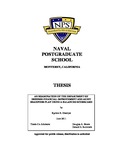Balanced Scorecard: A Strategic Tool in Implementing Homeland Security Strategies
| dc.contributor.author | Caudle, Sharon | |
| dc.date | 2008-10 | |
| dc.date.accessioned | 2013-01-03T16:26:49Z | |
| dc.date.available | 2013-01-03T16:26:49Z | |
| dc.date.issued | 2008-10-00 | |
| dc.identifier.citation | Homeland Security Affairs (October 2008), v.4 no.3 | |
| dc.identifier.uri | https://hdl.handle.net/10945/25042 | |
| dc.description | This article appeared in Homeland Security Affairs (October 2008), v.4 no.3 | en_US |
| dc.description.abstract | Starting in the early 1990s, Robert S. Kaplan and David P. Norton advocated a 'balanced scorecard' translating an organization's mission and existing business strategy into specific strategic objectives that could be linked in cause and effect relationships and measured operationally. The balanced scorecard stressed drivers of future organizational performance -- capabilities, resources, and business processes -- and the outcome results of those drivers. This article describes and illustrates the balanced scorecard as a tool to better implement homeland security strategies. | en_US |
| dc.language.iso | en_US | |
| dc.publisher | Monterey, California. Naval Postgraduate School | en_US |
| dc.publisher | Center for Homeland Defense and Security | en_US |
| dc.rights | The copyright of all articles published in Homeland Security Affairs rests with the author[s] of the articles. Any commercial use of Homeland Security Affairs or the articles published herein is expressly prohibited without the written consent of the copyright holder. Anyone can copy, distribute, or reuse these articles as long as the author and original source are properly cited. | en_US |
| dc.title | Balanced Scorecard: A Strategic Tool in Implementing Homeland Security Strategies | en_US |
| dc.type | Article | en_US |
| dc.description.distributionstatement | Approved for public release; distribution is unlimited. |





